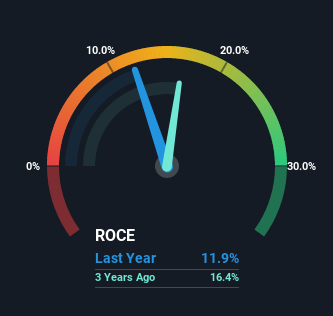[ad_1]
There are a few key trends to look for if we want to identify the next multi-bagger. Firstly, we’d want to identify a growing return on capital employed (ROCE) and then alongside that, an ever-increasing base of capital employed. Put simply, these types of businesses are compounding machines, meaning they are continually reinvesting their earnings at ever-higher rates of return. Although, when we looked at Sundart Holdings (HKG:1568), it didn’t seem to tick all of these boxes.
Return On Capital Employed (ROCE): What Is It?
For those who don’t know, ROCE is a measure of a company’s yearly pre-tax profit (its return), relative to the capital employed in the business. The formula for this calculation on Sundart Holdings is:
Return on Capital Employed = Earnings Before Interest and Tax (EBIT) ÷ (Total Assets – Current Liabilities)
0.12 = HK$371m ÷ (HK$6.1b – HK$3.0b) (Based on the trailing twelve months to June 2022).
Thus, Sundart Holdings has an ROCE of 12%. That’s a relatively normal return on capital, and it’s around the 11% generated by the Consumer Durables industry.
View our latest analysis for Sundart Holdings

In the above chart we have measured Sundart Holdings’ prior ROCE against its prior performance, but the future is arguably more important. If you’d like to see what analysts are forecasting going forward, you should check out our free report for Sundart Holdings.
So How Is Sundart Holdings’ ROCE Trending?
When we looked at the ROCE trend at Sundart Holdings, we didn’t gain much confidence. To be more specific, ROCE has fallen from 24% over the last five years. And considering revenue has dropped while employing more capital, we’d be cautious. If this were to continue, you might be looking at a company that is trying to reinvest for growth but is actually losing market share since sales haven’t increased.
While on the subject, we noticed that the ratio of current liabilities to total assets has risen to 49%, which has impacted the ROCE. If current liabilities hadn’t increased as much as they did, the ROCE could actually be even lower. And with current liabilities at these levels, suppliers or short-term creditors are effectively funding a large part of the business, which can introduce some risks.
In Conclusion…
We’re a bit apprehensive about Sundart Holdings because despite more capital being deployed in the business, returns on that capital and sales have both fallen. We expect this has contributed to the stock plummeting 90% during the last five years. That being the case, unless the underlying trends revert to a more positive trajectory, we’d consider looking elsewhere.
One final note, you should learn about the 3 warning signs we’ve spotted with Sundart Holdings (including 1 which is concerning) .
For those who like to invest in solid companies, check out this free list of companies with solid balance sheets and high returns on equity.
Valuation is complex, but we’re helping make it simple.
Find out whether Sundart Holdings is potentially over or undervalued by checking out our comprehensive analysis, which includes fair value estimates, risks and warnings, dividends, insider transactions and financial health.
View the Free Analysis
Have feedback on this article? Concerned about the content? Get in touch with us directly. Alternatively, email editorial-team (at) simplywallst.com.
This article by Simply Wall St is general in nature. We provide commentary based on historical data and analyst forecasts only using an unbiased methodology and our articles are not intended to be financial advice. It does not constitute a recommendation to buy or sell any stock, and does not take account of your objectives, or your financial situation. We aim to bring you long-term focused analysis driven by fundamental data. Note that our analysis may not factor in the latest price-sensitive company announcements or qualitative material. Simply Wall St has no position in any stocks mentioned.
[ad_2]
Source link







